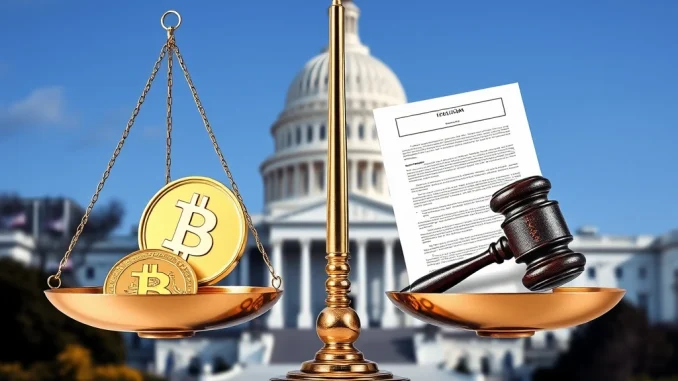
The ongoing quest for regulatory certainty in the United States has taken a significant turn. For anyone involved in or watching the cryptocurrency space, the lack of clear rules has been a constant challenge. A recent development in Congress, specifically the introduction of the Digital Asset Market CLARITY Act, is being viewed by some industry leaders as a potential game-changer.
Why is the CLARITY Act a Big Deal?
Stuart Alderoty, Chief Legal Officer at Ripple, wasted no time in sharing his positive view on this proposed legislation. Taking to X (formerly Twitter), Alderoty stated that the bipartisan CLARITY Act, introduced in the U.S. Congress, represents a major step forward for comprehensive US crypto regulation. His sentiment echoes a widespread desire within the industry for rules that provide certainty rather than ambiguity.
Alderoty emphasized the core principle behind the bill’s name:
- “Clarity shouldn’t be controversial.”
- “This bill moves us closer to a smart, workable crypto framework.”
This statement highlights the frustration often felt by companies operating with digital assets in the US, where determining whether a token is a security or a commodity has been a frequent point of contention, particularly in legal battles involving entities like the SEC and companies such as Ripple.
What Does the CLARITY Act Aim to Achieve?
While the full text and implications of the Digital Asset Market Clarity Act are subject to detailed review and potential amendments, its stated goal is to provide much-needed definitions and classifications for digital assets. The current regulatory landscape in the US is often described as a patchwork, with different agencies asserting jurisdiction and applying existing, sometimes ill-fitting, rules to novel technology.
Key areas the Act is expected to address include:
- Defining and distinguishing different types of digital assets.
- Establishing clear jurisdictional lines between regulatory bodies like the SEC and CFTC.
- Setting rules for secondary market transactions involving digital assets.
Achieving clarity in these areas is seen as crucial for fostering innovation and protecting consumers within the US market. Without it, businesses face uncertainty, making it difficult to build, invest, and operate effectively.
The Need for a Clear Crypto Framework
The crypto industry has long advocated for a clear and predictable regulatory environment. A well-defined crypto framework would provide guideposts for developers, investors, and businesses, encouraging growth while mitigating risks. The current approach, often relying on enforcement actions rather than clear rules, has been criticized for stifling innovation and driving businesses overseas.
Alderoty’s comments reflect the hope that the CLARITY Act can help move the US away from regulation by enforcement towards a more proactive and constructive approach to US crypto regulation. For companies like Ripple, which has been engaged in a prolonged legal battle over the classification of its XRP token, regulatory certainty is paramount for future operations and market participation in the US.
Implications for Digital Assets and the Market
Passage of legislation like the CLARITY Act could have significant implications for the broader market for digital assets. Increased regulatory certainty could:
- Attract more institutional investment.
- Encourage traditional financial institutions to engage with crypto.
- Provide better protection for retail investors through clear rules and oversight.
- Foster a more competitive and innovative US crypto ecosystem.
Conversely, failure to pass meaningful legislation or the introduction of overly burdensome rules could continue to hinder growth and push activity to other jurisdictions.
What Happens Next?
The introduction of the CLARITY Act is just one step in the legislative process. The bill must navigate committees, potential amendments, and votes in both the House and Senate before potentially becoming law. There will undoubtedly be debate and differing views on its provisions.
However, the bipartisan nature of its introduction suggests a growing recognition in Congress of the need to address US crypto regulation head-on. The positive reception from key industry figures like Ripple’s CLO indicates that the bill is seen as a constructive effort towards building a necessary crypto framework.
Conclusion: A Step Towards Regulatory Peace?
Stuart Alderoty’s endorsement of the Digital Asset Market CLARITY Act underscores the critical need for regulatory certainty for digital assets in the United States. While the path to comprehensive US crypto regulation is still long, the introduction of this bipartisan bill is a promising development. It signals a legislative effort to provide the clear crypto framework that the industry, including companies like Ripple, has been seeking. The journey continues, but for now, many see this as a hopeful sign of progress towards a more predictable future for crypto in the US.



